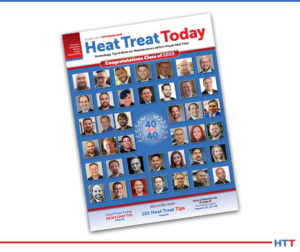 One of the great benefits of a community of heat treaters is
One of the great benefits of a community of heat treaters is  the opportunity to challenge old habits and look at new ways of doing things. Heat Treat Today’s 101 Heat Treat Tips is another opportunity to learn the tips, tricks, and hacks shared by some of the industry’s foremost experts.
the opportunity to challenge old habits and look at new ways of doing things. Heat Treat Today’s 101 Heat Treat Tips is another opportunity to learn the tips, tricks, and hacks shared by some of the industry’s foremost experts.
For Heat Treat Today’s latest round of 101 Heat Treat Tips, click here for the digital edition of the 2019 Heat Treat Today fall issue (also featuring the popular 40 Under 40).
Today’s Technical Tuesday features a tip from Jim Oakes of Super Systems, Inc, covering Probes. Jim's tip suggests some fundamental procedures that should be performed properly to maximize carbon/oxygen probe life.
Are you not getting the life that you would expect from your carbon/oxygen probe? There are some fundamental procedures that should be performed properly to maximize probe life.
1. Clean reference air. The probe needs a fresh source of air provided in the reference air fitting to ensure that the partial pressure of air is consistent. This will provide accuracy in the carbon calculation, and assuming the air does not contain any contaminates, it will lead to longer life under normal use.
2. Proper burnoff procedures. Make sure that you follow the manufacturer's recommendation on probe burnoff. Frequency and duration are dependent on the application (temperature, atmosphere, cycle time, and furnace), but regardless of these, ensuring a probe burnoff's effectiveness can be measured by watching what happens during the burnoff.
a. Probe mV. The probe mV is the best indication that a burnoff is effectively performed. Soot deposition occurs in two critical locations: the annular space between the sheath and the measuring surface, and at the measuring junction between the zirconia and the contact point with the sheath, which is the measuring electrode. The burnoff is performed to remedy this. Burnoff air is forced down the probe on the inside of the sheath but the outside of the probe substrate to force any buildup of soot/carbon on the probe where it can cause electrical connection issues and attack the probe sheath or create a carbon ring internal to the probe. By watching the mV during the burnoff, you should see them drop to 200mV or below during the burnoff process. This information will provide evidence that the burnoff is effective. If you are not getting the mV below that value, then there is not enough air flowing through the airway to force out any soot. Reasons could be:
i. The burnoff pump is not providing enough flow (Super Systems Inc.-SSI recommends 10 scfh or greater.).
ii. The pressure/agitation of the furnace is greater than what the burnoff pump can provide. If the burnoff pump is sized properly and properly working, the timing of the burnoff may need to occur when there is a relief in pressure (inner door opens) or temporarily turning the fan off during the burnoff.
iii. The probe has already been sooted up and should be evaluated for a carbon ring and blockage in that airway.
b. Assuming you have a thermocouple in the tip of the probe, you can monitor the temperature. If the tip superheats, it can damage the tip and in some cases oxidize the tip of the probe. The probe tip should not exceed the furnace temperature by more than 100 degrees.
3. Frequency is dependent upon the environment the probe is exposed to. At the least, SSI recommends performing a burnoff once a day but will suggest increasing that based on the atmosphere setpoint, use of stop-off paint, and length of heat treat cycles. Avoid a frequency of fewer than 6 hours if possible. The duration of the burnout should not exceed 90 seconds. A good way to measure the effectiveness is based on the mV reading dropping below 200.






